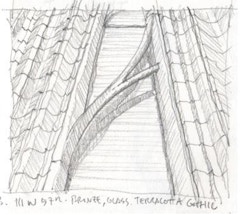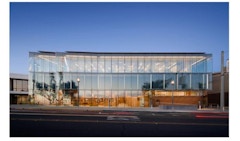
134 results
-
 Facade engineering aims at appropriately balancing the demands imposed by the context and the capabilities inherent to the materials, the geometries…
Facade engineering aims at appropriately balancing the demands imposed by the context and the capabilities inherent to the materials, the geometries… -

Structural Skin: Integrating Structure and Cladding
From gothic masonry to the sculptural building facades of today, exposed structural surfaces are often the most defining element of architecture. Increasingly, however, designers sit at a nexus of these aesthetic considerations and performance-driven design.
-
Structural Skin
- Paper by John Neary, Sr. Façade Specialist
Many prominent, recent buildings feature forms suggesting structural surface while their enclosures are really non-load-bearing curtain wall. At the… -
Shaping Skin
- Paper by John Neary AIA LEED AP NCARB
The conventional modern facade is essentially flat, which creates the tendency toward visual monotony and problems for modulating daylight—both on
-

Structuring Skin
- Paper by John Neary,
Curtain wall is the prevailing type of enclosure on modern buildings because of its economy, its independence from structure that allows flexibility… -
The Double Skin Facade
- Paper by Lee A. Fithian, AIA, AICP, NCARB, LEED AP
The largest source of air pollution in North America is the atmospheric boundary layer of a city caused by its urban canyons with pollutants produced
-

Differentiated Building Skin
- Paper by James Warton,
The Los Angeles Stadium’s doubly curved skin is composed of over 35,000 unique triangular panels covering 296,502 square feet of surface area. The… -

The Performative Double-Skin
- Paper by Jeffrey Abramson, AIA, LEED AP, Associate Principal Alejandra Menchaca, PhD, LEED AP, WELL AP, Vice President
Double-Skin Facades (DSF) are well-known to boost the thermal performance of a façade: they can provide extra insulation in the wintertime and lower… -

A Compact, Unitized Double Skin Facade
- Paper by Alex Cox, LEED AP, James Hock, LEED AP BD+C, Laura Ziegler, Karin Lamberts,
Driven by an increasing demand for high thermal and acoustic performance, transparency, and low maintenance costs, a number of facade innovations… -

-

Performance of Compact, Closed Cavity, Double-skin Curtain Wall
- Paper by Julien Schwartz, M. Eng., Building Energy Consultant Katie Hay, P. Eng., Building Science Consultant Stéphane Hoffman, M. Arch., M. Eng, PE, Vice President, Building Science Analytics
A proposed design for a compact, closed cavity, double-skin curtain wall system in the Marine climate of the West Coast raises questions of potential… -

Determining the Optimal Opening for Multi Skin Facade with External Ventilation
- Paper by Peter Simmonds,
The envelope of the Harbin Bank Building in Beijing has a Multi-Skin Facade where the outer cavity is naturally ventilated. During the design the… -

Event Passed
–Facade Tectonics Forum: CTBUH 2015 New York
Forum by Facade Tectonics Institute, Inc.
-
Unitized Cavity Wall Design and Implementation
- Paper by Dan Bettenhausen, Ph.D.
Double Skin Facades (DSF), constructed from individual aluminum framed curtain wall assemblies, provide a means of achieving acoustic and thermal
-

ETFE Membrane Envelope Strategies
- Paper by Audrey L Worden, ISSF · Kihong R. Ku, DDes · Alexander G. Worden, RA NCARB
Airflow within the cavity of double-skin facades is a key component of adaptive building envelopes which change thermophysical properties to meet
-
The Thermal Blanket Concept
- Paper by Bharat Patel, PE, CEM, LEED AP · Michael Bulander, AIA, LEED AP
This paper tells the story of a Double Skin Facade (DSF), where high performance and multi-disciplinary collaboration saves a library concept of
-

Thermal Performance of Closed Cavity Facades
- Paper by Andrea Zani, Project Engineer Carmelo Guido Galante, Senior Project Engineer Lisa Rammig, Senior Associate
Closed cavity facades (CCF), a configuration of Double Skin Facade (DSF), consists of a double-glazed unit on the inner layer and single glazing on… -

Net Zero Tower
- Article by John Neary, AIA, LEED AP NCARB, Senior Facade Specialist
John Neary describes a collaborative Advanced design Studio at City Tech that involved Permasteelisa, Skanska and Onyx Solar, with links to the published student works.
-

Case Study: Renovation of Fountain Place
- Paper by Alfonso Lopez P.E., Principal and CEO David Dunham P.E, Director of Business Development Diarmuid Kelleher P.E., S.E., Director of Engineering
Fountain Place is a project that exemplifies the latest technology and applications in building skin design and jumbo structural glass applications,… -

Episode 11: Embodied Carbon
- Podcast by Anthony Pak · Jennifer O'Connor
Special guests Jennifer O'Connor from Athena Sustainable Materials Institute, Anthony Pak from Priopta, and Stacy Smedley from Skanska join us to discuss embodied carbon.


